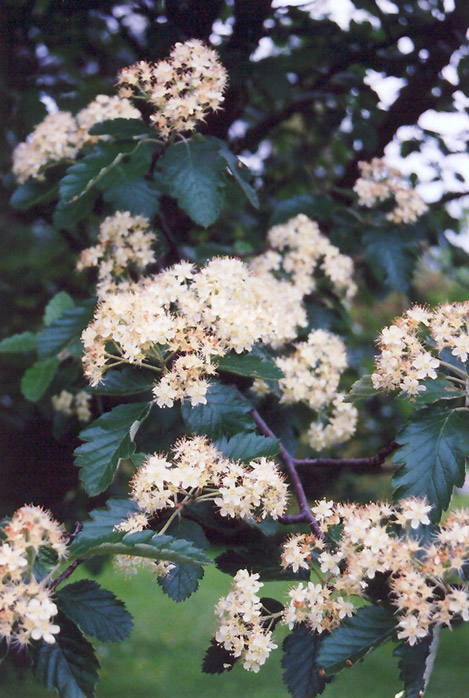Digging deeperPlant Library
Height: 35 feet
Spread: 25 feet
Sunlight:
![]()
![]()
Hardiness Zone: 4
Other Names: Hybrid Mountain Ash
Description:
A naturally occuring hybrid, this beautiful accent tree features interesting semi-compound leaves that turn yellow and orange in fall; showy clusters of white flowers in spring and red berries in fall; needs well drained soil, resistant to disease
Ornamental Features
Swedish Whitebeam features showy clusters of white flowers held atop the branches in mid spring. The orange fruits are held in abundance in spectacular clusters from early to late fall. It has dark green deciduous foliage. The serrated oval leaves turn an outstanding orange in the fall. The smooth gray bark adds an interesting dimension to the landscape.
Landscape Attributes
Swedish Whitebeam is a deciduous tree with a more or less rounded form. Its average texture blends into the landscape, but can be balanced by one or two finer or coarser trees or shrubs for an effective composition.
This is a relatively low maintenance tree, and is best pruned in late winter once the threat of extreme cold has passed. It is a good choice for attracting birds and bees to your yard. It has no significant negative characteristics.
Swedish Whitebeam is recommended for the following landscape applications;
- Accent
- Shade
Planting & Growing
Swedish Whitebeam will grow to be about 35 feet tall at maturity, with a spread of 25 feet. It has a low canopy with a typical clearance of 4 feet from the ground, and should not be planted underneath power lines. It grows at a fast rate, and under ideal conditions can be expected to live for 50 years or more.
This tree does best in full sun to partial shade. It prefers to grow in average to moist conditions, and shouldn't be allowed to dry out. It is not particular as to soil type or pH. It is somewhat tolerant of urban pollution. Consider applying a thick mulch around the root zone in winter to protect it in exposed locations or colder microclimates. This particular variety is an interspecific hybrid.
A NetPS Plant Finder tool
This Plant Library is for informational purposes only. We may or may not carry the items listed. During many times of the year, we may carry many more plants in our store than are listed in the Plant Library. Please contact us directly at 303-690-4722 or visit our store for current availability and for assistance.

